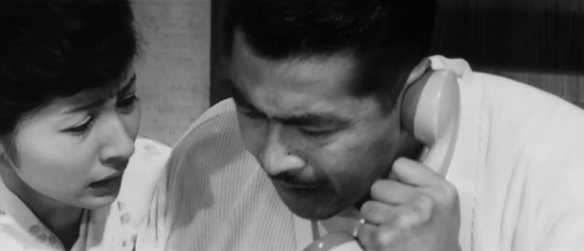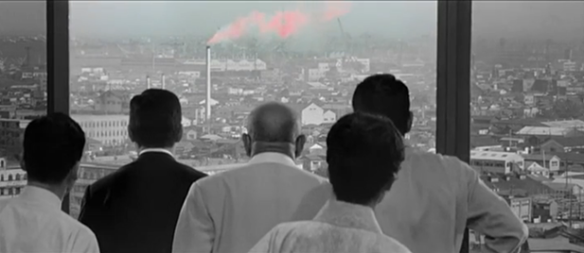 High and Low (or Heaven and Hell in the original Japanese) is a yin and yang film about the polarity of man in many ways. Gondo (Toshiro Mifune) is an affluent executive in the National Shoe Company. He worked his way up the corporate ladder from the age 16, because of his determination and commitment to a quality product. Now his colleagues want his help in forcing the company’s czar out. They come to his modernistic hilltop abode to get his support. Instead, they receive his ire, splitting in a huff. What follows is a risky plan of action from Gondo that is both fearless and shrewd. He takes all his capital to buy stock in the company so he can take over, but his whole financial stability hangs in the balance. He knows exactly what it means, but he wasn’t suspecting certain unforeseen developments.
High and Low (or Heaven and Hell in the original Japanese) is a yin and yang film about the polarity of man in many ways. Gondo (Toshiro Mifune) is an affluent executive in the National Shoe Company. He worked his way up the corporate ladder from the age 16, because of his determination and commitment to a quality product. Now his colleagues want his help in forcing the company’s czar out. They come to his modernistic hilltop abode to get his support. Instead, they receive his ire, splitting in a huff. What follows is a risky plan of action from Gondo that is both fearless and shrewd. He takes all his capital to buy stock in the company so he can take over, but his whole financial stability hangs in the balance. He knows exactly what it means, but he wasn’t suspecting certain unforeseen developments.
Then in a matter of moments, everything changes. Gondo gets a menacing phone call claiming that his young boy is kidnapped and an astronomical sum of money is expected in return. Gondo and then his wife are instantly horrified by the news only to be relieved when their boy winds up unharmed. The same’s not true for his chauffeur’s boy Shinichi. The mistake in identity is obvious, but it makes no difference to the perpetrator because he still has leverage. He wants to make Gondo sweat since this is more than an isolated incident. He wants to make the man suffer – bringing him down to the level of all the unfortunate souls who live in the wasteland down below.
 At this point, the police are called and they arrive incognito, ready to stake out the joint and do the best they can to get the boy back safe and sound. This section of the film almost in its entirety takes place within the confines of Gondo’s house and namely the front room overlooking the city. It’s the perfect set up for Akira Kurosawa to situate his actors. He uses full use of the widescreen and his fluid camera movements keep them perfectly arranged within the frame.
At this point, the police are called and they arrive incognito, ready to stake out the joint and do the best they can to get the boy back safe and sound. This section of the film almost in its entirety takes place within the confines of Gondo’s house and namely the front room overlooking the city. It’s the perfect set up for Akira Kurosawa to situate his actors. He uses full use of the widescreen and his fluid camera movements keep them perfectly arranged within the frame.
Although the number of bodies also increases the anxiety in the space with Gondo at the center of it all trying to figure out what to do. Moral issues begin bubbling up that no man would have to deal with and yet they end up right in his lap. His whole business empire that he’s given his heart and soul to hangs in the balance of this decision, but he must make it nonetheless. Make the difficult choice to pay the ransom and do what’s moral, or not pay it and maintain his financial stability. For once in his life, their’s a hesitancy.
It’s as if he’s getting pulled back and forth with his wife chiding him, “Success isn’t worth losing your humanity,” while his opportunistic right-hand man is chomping at the bit to get a move on. He’s not going to allow his superior to sink all their prospects at financial gain.
As things progress, we finally move from the living room to the train where Gondo prepares to make the drop, but his adversary has planned out everything and has a clean getaway. The money is gone and now the police double their efforts. Meanwhile, behind the scenes, his backers are prepared to push Gondo out, because of his inability to pay them. Public opinion soars for the selfless act, and we finally meet our protagonist’s unknown adversary.
Really this second leg of the film is mostly about the procedural aspect as they begin hitting the pavement canvassing and trying to close in on the culprit. This section intercuts the reports going on at headquarters with actual police work on the streets and it’s strangely engaging.
 Finally, with the help of Shinichi, they make a startling discovery that ties back to the kidnapper. And the boy’s drawings along with a colorful stream of smoke help them move in ever closer. What follows is an elaborate web of trails through the streets as they work to catch the culprit in his crime, to put him away for good. And it works.
Finally, with the help of Shinichi, they make a startling discovery that ties back to the kidnapper. And the boy’s drawings along with a colorful stream of smoke help them move in ever closer. What follows is an elaborate web of trails through the streets as they work to catch the culprit in his crime, to put him away for good. And it works.
 But High and Low cannot end there without a consideration of the consequences. Gondo has been brought low. He’s losing his mansion and must start a new job on the bottom of the food chain once more. His enemy requests a final meeting as he prepares for his imminent fate, and this is perhaps the most grippingly painful scene. Gondo’s face-to-face with the man who made him suffer so much. Toshiro Mifune’s violent acting style serves him well as he wrestles so intensely with his own conscience. And yet at this junction, he is past that. What is he to do but listen? In this way, it’s difficult to know who to feel sorrier for — the man who is resigned to a certain fate passively or the one who goes out proud and arrogantly against death. Both have entered some dark territory and it’s no longer about high or low or even heaven and hell. They’re stuck in some middle ground. An equally frightening purgatory.
But High and Low cannot end there without a consideration of the consequences. Gondo has been brought low. He’s losing his mansion and must start a new job on the bottom of the food chain once more. His enemy requests a final meeting as he prepares for his imminent fate, and this is perhaps the most grippingly painful scene. Gondo’s face-to-face with the man who made him suffer so much. Toshiro Mifune’s violent acting style serves him well as he wrestles so intensely with his own conscience. And yet at this junction, he is past that. What is he to do but listen? In this way, it’s difficult to know who to feel sorrier for — the man who is resigned to a certain fate passively or the one who goes out proud and arrogantly against death. Both have entered some dark territory and it’s no longer about high or low or even heaven and hell. They’re stuck in some middle ground. An equally frightening purgatory.
Yes, this works as an indictment of the justice system and even the capitalistic framework of an industrialist post-war Japan, but it’s even more so an acknowledgment of man’s own morality and mortality. We are far from indestructible, unfaltering beings.
4.5/5 Stars
